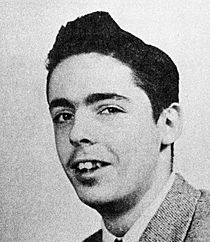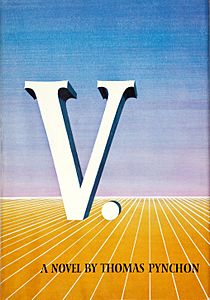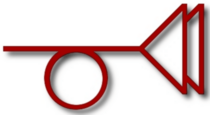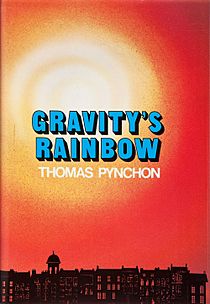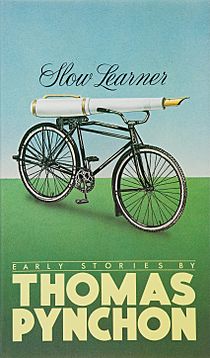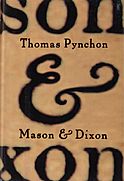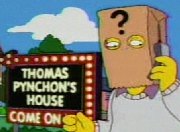Thomas Pynchon facts for kids
Quick facts for kids
Thomas Pynchon
|
|
|---|---|
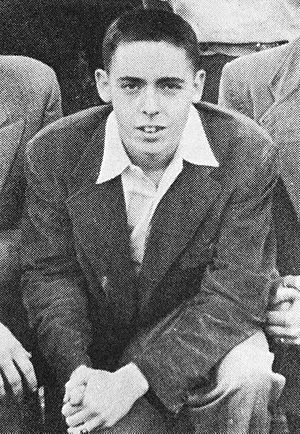
Pynchon in a 1953 yearbook image
|
|
| Born | Thomas Ruggles Pynchon Jr. May 8, 1937 Glen Cove, New York, U.S. |
| Education | Cornell University (BA) |
| Period | c. 1959–present |
| Literary movement | Postmodern literature |
| Notable works |
|
| Spouse |
Melanie Jackson
(m. 1990) |
| Children | 1 |
| Signature | |
Thomas Ruggles Pynchon Jr. (born May 8, 1937) is an American novelist famous for his detailed and complex books. His stories cover a wide range of subjects, including history, music, science, and math. For his novel Gravity's Rainbow, Pynchon won the U.S. National Book Award for Fiction in 1974. Many people consider him one of the greatest American writers.
Pynchon grew up on Long Island, New York. He served for two years in the United States Navy and later earned an English degree from Cornell University. After publishing a few short stories, he wrote the novels that made him famous: V. (1963), The Crying of Lot 49 (1966), and Gravity's Rainbow (1973). His 2009 novel, Inherent Vice, was made into a movie in 2014.
Pynchon is known for being very private and avoiding the media. Few photos of him exist, and people have wondered about his identity and where he lives since the 1960s. His most recent novel, Shadow Ticket, was published in 2025.
Contents
Early Life and Education
Thomas Pynchon was born on May 8, 1937, in Glen Cove, New York. He was one of three children. His father, Thomas Ruggles Pynchon Sr., was an engineer and politician, and his mother, Katherine Frances Bennett, was a nurse.
Pynchon was a strong student and writer from a young age. He attended Oyster Bay High School, where he was named "student of the year." He also wrote short stories for his school newspaper. These early writings included some of the themes he would use later in his career, like unusual names and humor.
|
Thomas Pynchon
|
|
|---|---|
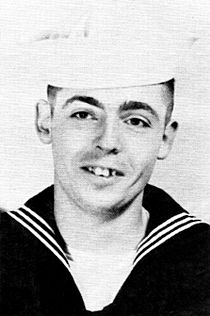
Pynchon c. 1955
|
|
| Allegiance | |
| Branch | |
| Service years | 1955–1957 |
| Service number | 4881936 |
Pynchon graduated from high school in 1953 at age 16. He then went to Cornell University to study engineering physics. After his second year, he joined the U.S. Navy. He trained to be an electrician and served on the destroyer USS Hank in the Mediterranean Sea during the Suez Crisis of 1956.
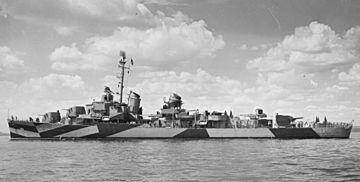
In 1957, Pynchon returned to Cornell to study English. His first published story, "The Small Rain," appeared in the Cornell Writer in 1959. Many of his later stories would draw on his experiences in the Navy.
At Cornell, Pynchon became friends with other writers like Richard Fariña. He also reportedly attended lectures by the famous author Vladimir Nabokov. Nabokov's wife, Véra, who graded papers for the class, remembered Pynchon's unique handwriting. It was a mix of printed and cursive letters. Pynchon graduated with honors in June 1959.
Writing Career
First Novels
After leaving Cornell, Pynchon worked as a technical writer for the company Boeing in Seattle. He wrote safety articles for a newsletter about the BOMARC missile. His time at Boeing gave him ideas for his novels V. and The Crying of Lot 49.
His first novel, V., was published in 1963. It won an award for being a notable first novel and was praised by critics. A review in The New York Times called Pynchon "a writer of staggering promise."
Pynchon's second novel, The Crying of Lot 49, came out in 1966. It is shorter and more straightforward than his other books. The story follows a woman named Oedipa Maas as she uncovers a series of strange connections and a secret, ancient mail service. The book is known for its mix of science, history, and humor. It was named one of the 100 best English-language novels by Time magazine.
In 1966, Pynchon also wrote an article for The New York Times Magazine about the Watts Riots in Los Angeles.
Gravity's Rainbow
Pynchon's most famous novel is Gravity's Rainbow, published in 1973. It is a long and complex book that explores many of the themes from his earlier work, such as paranoia and history. Many critics and scholars have compared its importance to James Joyce's famous novel Ulysses.
The story is mostly set in Europe during the final months of World War II. The book is known for its encyclopedic style, covering topics from psychology and chemistry to music and film. Pynchon wrote the first draft on special graph paper in neat, tiny script.
Gravity's Rainbow won the 1974 National Book Award. The jury for the Pulitzer Prize also recommended it for the award, but the Pulitzer board disagreed, calling the novel "unreadable." No prize for fiction was given that year.
Later Novels
In 1984, Pynchon published Slow Learner, a collection of his early short stories. It included a long introduction where he wrote about his own life and work, which was rare for him.
Pynchon's fourth novel, Vineland, was published in 1990. Set in California, it tells the story of a filmmaker and an FBI agent. The book explores the conflict between authority and freedom with Pynchon's usual humor.
His next novel, Mason & Dixon (1997), is a historical story about the two English surveyors who created the Mason–Dixon line in America. The book is written in a style that mimics 18th-century writing. It features historical figures like George Washington and Benjamin Franklin. Critics praised the novel, with some calling it his best work.
Other novels by Pynchon include:
- Against the Day (2006): A very long novel that takes place between the 1893 Chicago World's Fair and the years after World War I.
- Inherent Vice (2009): A detective story set in 1970s Los Angeles. It was adapted into a film by director Paul Thomas Anderson in 2014.
- Bleeding Edge (2013): Set in New York City between the dot-com bust and the events of September 11, 2001.
- Shadow Ticket (2025): A story about a private investigator from Milwaukee who travels to Hungary in 1932.
Style and Themes
Pynchon's writing is known for being complex and full of information. He often mixes serious topics with humor and pop culture references, like comic books and cartoons. This mix of "high" and "low" culture is a key part of his style.
A major theme in his books is the question of whether the world is controlled by secret plans (conspiracy) or is just random (chaos). His characters often feel like they are caught in huge, mysterious plots they can't understand.
Music is also very important in his novels. His books mention many types of music, from jazz and rock and roll to classical. He often includes funny song lyrics that he wrote himself. He was a fan of the anarchic bandleader Spike Jones and the rock musician Roky Erickson.
A Private Life
Thomas Pynchon is famous for avoiding publicity. He has not given an interview or been photographed publicly in over 50 years. This has led to many rumors about him.
In 1974, when he won the National Book Award, he sent the comedian "Professor" Irwin Corey to accept it for him. The comedian gave a rambling, funny speech that confused many people in the audience.
Pynchon has made a few rare appearances. He wrote and narrated a promotional video for his novel Inherent Vice. He also appeared as a cartoon character on the TV show The Simpsons, which he is a fan of. In his appearances, his face was hidden by a paper bag. He agreed to be on the show because his son was a big fan.
When a TV crew filmed him in Manhattan in 1997, he called the station and asked them not to use the footage. He told them, "My belief is that 'recluse' is a code word generated by journalists... meaning, 'doesn't like to talk to reporters'."
In 1990, Pynchon married his literary agent, Melanie Jackson. She is a great-granddaughter of President Theodore Roosevelt. They have one son, Jackson.
Despite his desire for privacy, Pynchon has occasionally spoken out on issues he cares about. He wrote in support of the author Salman Rushdie when Rushdie faced threats for his novel The Satanic Verses. The two authors later met and had dinner together.
See also
 In Spanish: Thomas Pynchon para niños
In Spanish: Thomas Pynchon para niños
- Postmodern literature
- Hysterical realism


